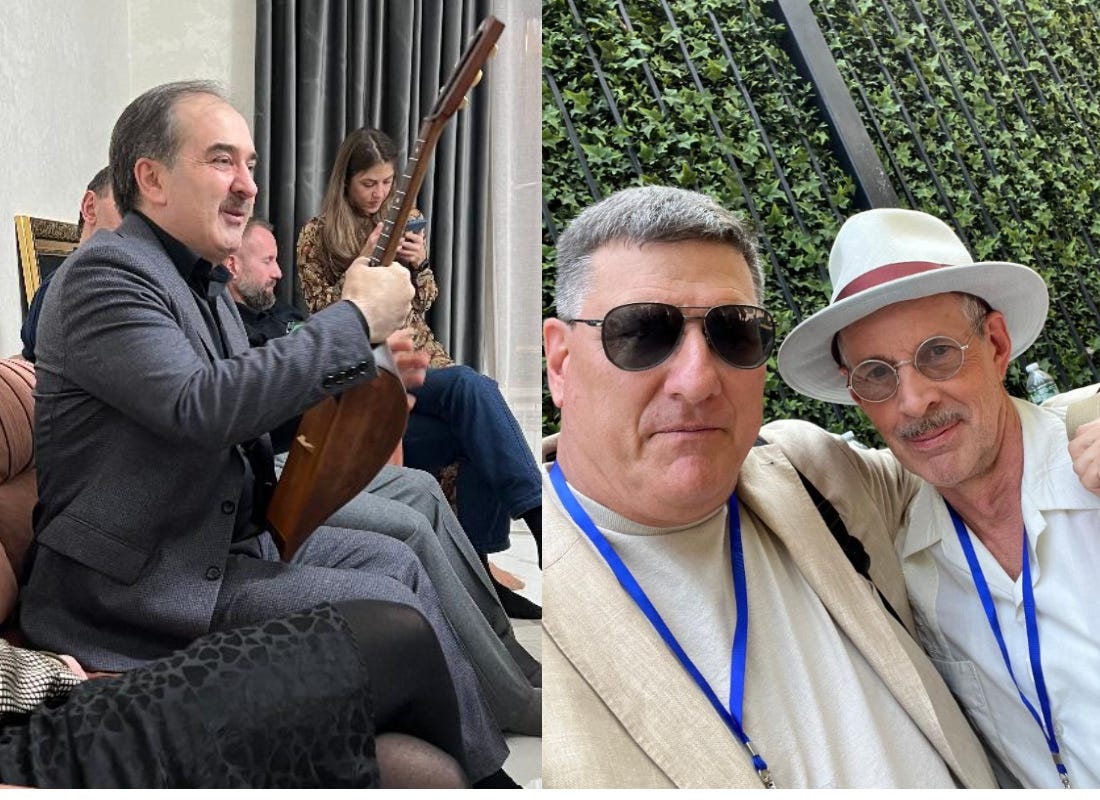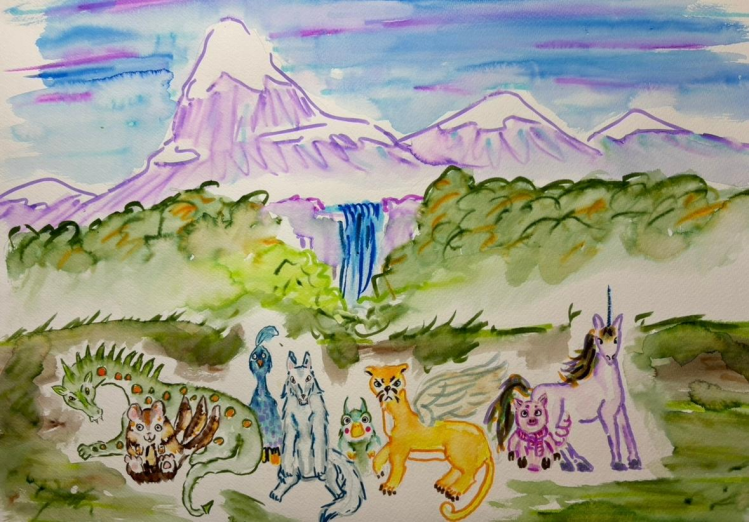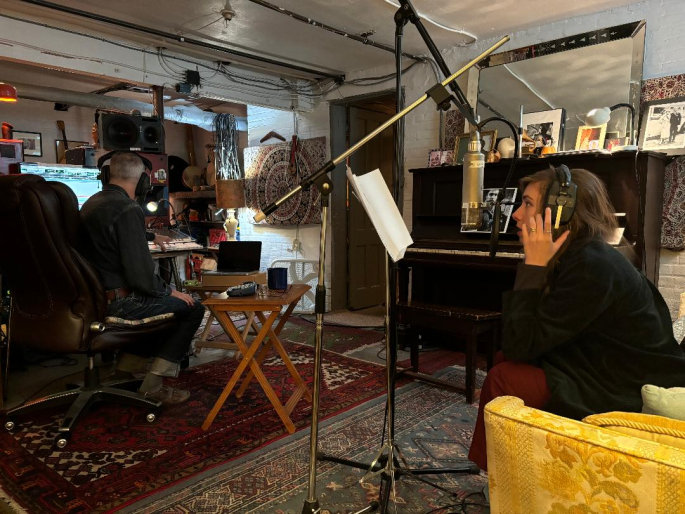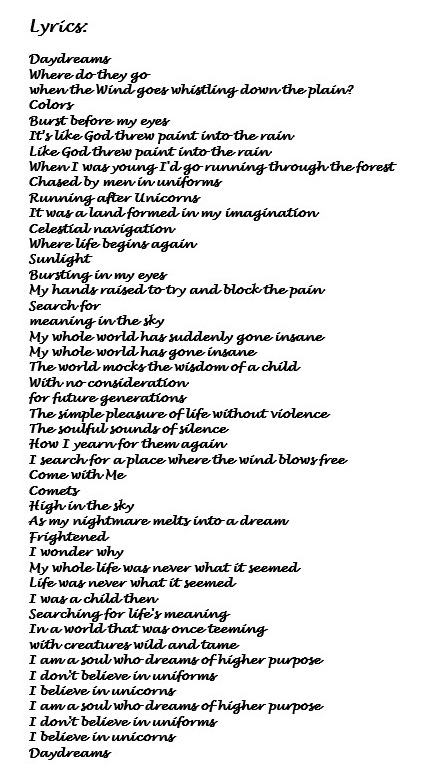Daydreams. Make Music Videos, Not War. Scott Ritter

About a year ago, I began to put in motion plans to make a documentary film about my trips to Russia, my friendship with Alexander Zyrianov (the Russian civic and business leader who, on his own initiative and expense, hosted me during my visits), and the message of peaceful cohabitation on the part of the American and Russian people these trips were designed to promote.
One of the components of this project was the idea of a compelling soundtrack. Roger Waters, the legendary frontman of the legendary band, Pink Floyd, who has gone on to win acclaim as a solo artist and compassionate and articulate advocate for peace and justice, had been kind enough to allow me to make use of his classic song about the danger of nuclear war, “Two Suns in the Sunset.” Given that the documentary was designed to tell a single story from a Russian and American perspective, I reached out to two famous artists from the Russian Federation—Shaman, perhaps the hottest ticket in Russian now (think Taylor Swift, but on steroids), and Ilyas Ebiev (the Chechen Elvis Presley) to see how we could bring about a collaboration.
I reached out to my good friend, the renowned composer and music producer, Malcolm Burn (who also hosts a fantastic weekly radio show, “The Long Way Around,” on Radio Kingston/WKNY 1440 AM), to see if he might be willing to bring his considerable experience and expertise into the mix on this project; to my immense delight, Malcolm agreed. I was in the process of lining up the “talent” and a studio for the trip I was planning to Russia in late December 2023 when Malcolm informed me that he was unable to travel for personal reasons. We both agreed that the project remained a worthy one, and that we would press forward when the time was right.
.

Ilyas Ebiev (left), the Author and Malcolm Burns (right)
.
Before Malcolm had to withdraw from the trip, I had sent him a piece of music that had been composed by my daughter, Patricia, when she was in Middle School. Malcolm listened to it, and reported back to me: “I can do something with this.”
“This” was a somber piano melody which my daughter had originally entitled “the theme song for Animara.”
Animara (an anagram of my wife’s name—Marina) was a make-believe world that Patricia and her twin sister, Victoria, had imagined after being traumatized by the Al Gore film, “An Inconvenient Truth,” which forecasted the end of life on earth because of climate change. In the many hours of conversation that followed, we discussed man’s relationship with Mother Nature, and the need for all of us to treat the planet we inhabit with greater respect.
Among the topics covered in these lengthy discourses was the danger posed by nuclear war. My daughters simply could not wrap their head around the logic of mutually assured destruction and, by extension, the purpose behind nuclear weapons—especially after we had learned from the dual bombings of Hiroshima and Nagasaki by the United States at the end of the Second World War. As our discussions turned from defining problems toward implementing solutions, Patricia and Victoria began imagining what a perfect world would look like if we could start from scratch and remove the human factor from the equation. This world was filled with fantastic creatures and complex ecosystems possessing both natural and social order.
They then populated it with human refugees who had fled a dying planet and were given the chance to start over.
What started as a pleasant exercise, however, devolved into tragedy, as may daughters, applying fact-based logic, quickly realized that the human race was self-destructively parasitic. In the end, the only way to save Animara was to purge it of the parasites.
I worked with my daughters to capture their stories on paper (we even completed the first volume of what was intended to be a multi-volume series), and both daughters would sketch out their vision of what Animara would look like, including elaborate depictions of the vegetation and life that the human refugees would find when they arrived.
.

The world of Animara, as envisioned by my daughters
.
Life intervened (and by life, I mean boys), and the imaginary world of Animara gave way to the drama of high school and beyond.
But Patricia’s song and the drawings she did with her sister, Victoria, remained with me.
This past June I was scheduled to return to Russia, where I was planning to complete filming of the documentary film. Malcolm and I had discussed the possibility of his helping produce music remotely, and I was planning on meeting with Russian music producers and musicians to see if we could record some songs that could be used in the film. One of the ideas I had was to let Shaman and others listen to the piano tune Patricia had recorded for Malcolm, and to see if it could be incorporated into an original new song that Shaman and others might record for us.
Fate once again conspired, in the form of the US government, which dispatched three Customs and Border Patrol agents to prevent me from traveling to Russia by seizing my passport just as I was about to board my flight.
With the documentary on hold, and no immediate prospects of being able to travel to Russia, I turned my attention to new projects, one of which was working with Gerald Celente, who was planning a “Peace & Freedom Rally” in Kingston, New York, scheduled for September 28. I had met with Gerald and our fellow co-conspirator, Judge Andrew Napolitano, back in June, where we talked about a shared vision of what the rally could look like. There, seated around a table overlooking the Catskill Mountains, I sketched out the idea for “Operation DAWN,” my plan for empowering Americans to save Democracy, America, and the World through their vote in November.
I had sold both Gerald and the Judge on my concern about the danger of nuclear war, and we all decided that I would make that the topic of a presentation I would be making at the rally.
Back home, I started thinking about how I would try and explain the importance of this issue to me in a way that would resonate with most Americans. One of the emotions I was feeling was anger—anger that my government, without consulting me, had embarked on a policy direction that had us on the cusp of a nuclear war no one was aware was about to be fought.
This wasn’t just a betrayal of the Constitutional Republic which the government was sworn to defend, but—perhaps more importantly—a personal betrayal of every American who had embraced the American dream of putting down roots and raising a family, working hard for a future which, because of the threat of nuclear war, might never come.
I was transported back in time to the conversations I had with my daughters about Animara and decided that the best way to capture the source of my anger would be to bring Animara to life in a way that could be shared with as broad an audience as possible.
There wasn’t time to turn the single volume of the Animara series into something that could be readily shared. Moreover, reading a dystopian children’s novel didn’t seem like the go-to move for a Saturday afternoon rally.
Patricia’s song, however, could be the ticket. I reached out to Malcolm, who agreed to make his studio and skills as a musician and music producer available. I then sat down and wrote some lyrics that I thought best captured the mood of the music and the message of Animara.
Originally, I had hoped we would be able to attract the talent of a certain well-known female singer who makes her home in the Kingston area and see if she would provide the vocals for what had become the song known as “Daydreams.” Time, however, was of the essence, so I asked Patricia to come to Kingston to lay down the piano track of her song, and to provide vocals which would then be re-recorded by the desired talent. Patricia reluctantly agreed—but on the condition that the version she recorded would not be shared with anyone outside Malcolm’s studio.
Image: My daughter, Patricia, in Malcolm Burn’s studio, recording the vocals to “Daydream.”

Having never been involved with the production of a record, I had no idea what to expect when my daughter and I entered Malcolm’s home studio. I can say we were immediately put at ease by the comfortable setting, which was more like entering a music museum (Malcolm has a world-class collection of guitars acquired over the years, many of them gifts from the various musicians he helped produce.)
Malcolm had Patricia play her piano piece several times, while recording. He made some suggestions, Patricia came up with some of her own, and pretty soon Malcolm said, “I think we got enough for a record.”
Patricia then—reluctantly—had herself recorded singing the lyrics.
Malcolm then added a bass track and—in a moment of inspired genius—added a children’s piano in the part of the song I had envisioned having more of a guitar jam. Malcolm did this after listening to my back-story about the origins of the song. He believed it best captured the essence of the child’s experience.
He was right.
Later, after Patricia and I left, Malcolm slapped some “cellos on the front and back” (a line from one of the many tales of producing big stars that Malcolm regaled us with during the recording session to put Patricia at ease.) The “cellos” were actually synthesized strings which gave the song a melodic quality that turned it from a simple tune into something much more powerful.
And thus was born the song “Daydreams.”
Unfortunately for Patricia, the female singer I had hoped for wasn’t available, and if we were going to go forward with the music video, it would be with Patricia’s voice—something she was adamantly opposed to.
.

Sam (left) and Victoria (right) making the illustrations used in the music video of “Daydreams”
.
While I struggled to change Patricia’s mind, I had another problem—how to turn a song into a music video. Operating off my vision of trying to capture the “spirit of Animara,” I turned to Patricia’s sister, Victoria, for help. Victoria had worked with her sister to illustrate the Animara world and story, and I asked her to help me recreate that world in a way that could be captured for use in a video.
We were running out of time. Victoria and her fiancé, Sam, came up to Delmar from their apartment in New York City, and camped out in the kitchen of my home, which I had pre-stocked with art supplies. I sketched out a very rough storyboard and described the emotions I was hoping to convey. Victoria and Sam did the rest, working non-stop for two days to turn theory into reality. I can say without fear of contradiction that their work exceeded in quality what would have been produced by a team of animators operating under similar time constraints and adapting to the whim of a fickle director.
Armed with the drawings, I then turned to Megan Zebrowski, a video editor I had originally retained to assist with the production of video shorts I was planning to produce in support of the planned visit to Russia. Megan was able to meld music and images into a video which perfectly captured the emotions I was trying to convey.
I got the video to the technical director of the Kingston rally on Thursday—three days before the rally.
And the rest is history.
I hope this song, as depicted in this video, moves a larger audience to come together to oppose the insanity of nuclear war.
The fact that I have helped bring to life visions drawn from the childhood of my daughters represents one of the greatest rewards a father could ever have.
Thank you, Vicka and Patty.
Your Father loves you very much.
This is for all the children in the world—the future generations—which are threatened by nuclear war.
I don’t believe in uniforms.
I believe in unicorns.
Come with me.
.
.

*
Click the share button below to email/forward this article to your friends and colleagues. Follow us on Instagram and Twitter and subscribe to our Telegram Channel. Feel free to repost and share widely Global Research articles.
Get Your Free Copy of “Towards a World War III Scenario: The Dangers of Nuclear War”!
All images in this article are from the author


